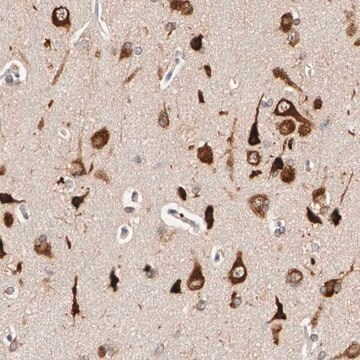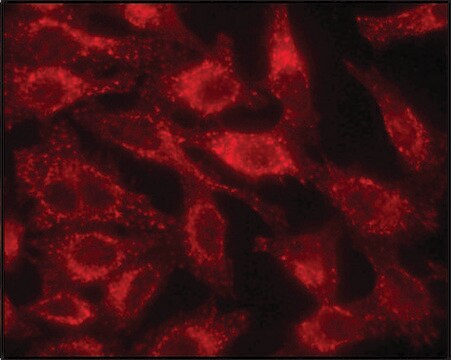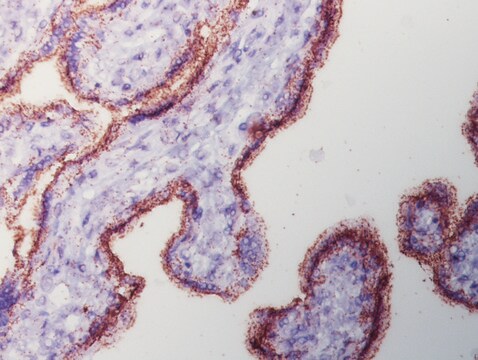推荐产品
生物源
rabbit
共軛
unconjugated
抗體表格
affinity isolated antibody
抗體產品種類
primary antibodies
無性繁殖
polyclonal
產品線
Prestige Antibodies® Powered by Atlas Antibodies
形狀
buffered aqueous glycerol solution
物種活性
human
技術
immunohistochemistry: 1:50-1:200
免疫原序列
EINDTCLSVATFLPYSSLTSGNVLQRTLSARMRRRERERSPDSFSMRRTLPPIEGTLGLSACFLPNSVFPRCSERNLQESVLSEQDLMQPEEPDYLLDEMTKEAEIDNSSTVESLGETTDILNMTHIMSLN
UniProt登錄號
運輸包裝
wet ice
儲存溫度
−20°C
目標翻譯後修改
unmodified
基因資訊
human ... RPGR(6103)
免疫原
X 连锁色素性视网膜炎 GTP 酶调节因子重组蛋白表位特征标签(PrEST)
應用
兔抗 RPGR 抗体是一种 Prestige 抗体,经人类蛋白质图谱(HPA)计划开发和验证。每种抗体都通过针对数百种正常和疾病组织的免疫组织化学进行测试。通过单击图像库链接,可以在人类蛋白质图谱(HPA)站点上查看这些图像。还采用免疫荧光和蛋白质印迹法对抗体进行检测。想要查看有关Prestige 抗体和HPA的方案和其他实用信息,请访问 sigma.com/prestige。
生化/生理作用
RPGR(色素性视网膜炎 GTP 酶调节因子)基因编码的蛋白与 Ran GTP 酶的鸟嘌呤核苷酸交换因子具有序列同源性。它在 N 端包含 6 个类似 RCC1 的结构域。它在感光细胞活力的长期维持中起作用。它存在于高尔基体中,并参与与 RPGRIP1(RPGR 相互作用蛋白 1)的相互作用,以介导与囊泡运输相关的过程。这两种蛋白质共定位于视杆细胞的外段。该基因的缺陷与连锁性视网膜色素变性(XLRP)有关。
特點和優勢
Prestige Antibodies®是经过高度表征和广泛验证的抗体,同时还有一个优点是其每个靶标的所有可用表征数据都可以通过位于此页面顶部产品名称下方的人类蛋白质图谱门户进行访问。Prestige Antibodies®对其他蛋白质的独特性和低交叉反应性是通过严密的抗原区域选择、亲和纯化和严格的选择来实现的。每种Prestige 抗体都有相应的Prestige 抗原对照品,可在链接部分找到。
每种Prestige 抗体的检测方法如下:
每种Prestige 抗体的检测方法如下:
- 44种正常人体组织和20种最常见癌症组织的IHC组织阵列。
- 364个人重组蛋白片段的蛋白阵列。
聯結
相应抗原APREST74315
外觀
磷酸盐缓冲盐水溶液,pH 7.2,含有40%甘油和0.02%叠氮化钠
法律資訊
Prestige Antibodies is a registered trademark of Merck KGaA, Darmstadt, Germany
免責聲明
除非我们的产品目录或产品附带的其他公司文档另有说明,否则我们的产品仅供研究使用,不得用于任何其他目的,包括但不限于未经授权的商业用途、体外诊断用途、离体或体内治疗用途或任何类型的消费或应用于人类或动物。
未找到合适的产品?
试试我们的产品选型工具.
儲存類別代碼
10 - Combustible liquids
水污染物質分類(WGK)
WGK 1
閃點(°F)
Not applicable
閃點(°C)
Not applicable
個人防護裝備
Eyeshields, Gloves, multi-purpose combination respirator cartridge (US)
William A Beltran et al.
Proceedings of the National Academy of Sciences of the United States of America, 112(43), E5844-E5853 (2015-10-16)
Inherited retinal degenerations cause progressive loss of photoreceptor neurons with eventual blindness. Corrective or neuroprotective gene therapies under development could be delivered at a predegeneration stage to prevent the onset of disease, as well as at intermediate-degeneration stages to slow
Christine Vössing et al.
International journal of molecular sciences, 22(7) (2021-04-04)
X-linked retinitis pigmentosa (XLRP) is frequently caused by mutations in the retinitis pigmentosa GTPase regulator (RPGR) gene. A complex splicing process acts on the RPGR gene resulting in three major isoforms: RPGRex1-19, RPGRORF15 and RPGRskip14/15. We characterized the widely expressed
M Dominik Fischer et al.
Molecular therapy : the journal of the American Society of Gene Therapy, 25(8), 1854-1865 (2017-05-28)
X-linked retinitis pigmentosa (XLRP) is generally a severe form of retinitis pigmentosa, a neurodegenerative, blinding disorder of the retina. 70% of XLRP cases are due to mutations in the retina-specific isoform of the gene encoding retinitis pigmentosa GTPase regulator (RPGRORF15). Despite
D H Hong et al.
Proceedings of the National Academy of Sciences of the United States of America, 97(7), 3649-3654 (2000-03-22)
The X-linked RP3 locus codes for retinitis pigmentosa GTPase regulator (RPGR), a protein of unknown function with sequence homology to the guanine nucleotide exchange factor for Ran GTPase. We created an RPGR-deficient murine model by gene knockout. In the mutant
R Roepman et al.
Human molecular genetics, 9(14), 2095-2105 (2000-08-25)
Mutations in the retinitis pigmentosa GTPase regulator (RPGR) gene cause X-linked retinitis pigmentosa type 3 (RP3), a severe, progressive and degenerative retinal dystrophy eventually leading to complete blindness. RPGR is ubiquitously expressed, yet mutations in the RPGR gene lead to
我们的科学家团队拥有各种研究领域经验,包括生命科学、材料科学、化学合成、色谱、分析及许多其他领域.
联系技术服务部门







